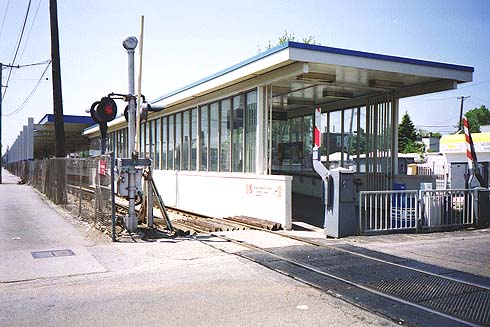
The main entrance to the
Cicero station, looking northwest in Cicero Avenue in 1999.
It's simple, modern, utilitarian design is typical of
facilities designed in the 1970s, such as Central
Park and
Pulaski
further east on the Douglas branch. For a larger view, click
here.
(Photo from the Chicago Transit
Authority Collection)
|
Cicero
(4800W/2200S)
Cicero Avenue and 21st
Place, Town of Cicero
Service
Notes:

|
Pink Line:
Cermak (Douglas)
|

|
Accessible
Station
|
Quick Facts:
|
Address:
|
2134 S. Cicero Avenue
(Cicero
entrance)
|
|
2133 S. 49th Avenue
(49th entrance,
exit only)
|
Established: December 16, 1907
Original Line: Metropolitan West Side Elevated, Douglas
Park branch
Previous Names: 48th Avenue
|
Skip-Stop Type:
|

|
Station
(1951-1958)
|

|
Station
(1958-1995)
|
Rebuilt: 1978
Status: In Use
History:
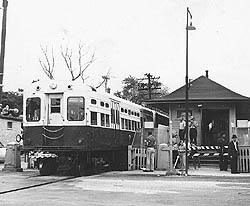
One is of
late-model 6000s passes the original station at Cicero in 1974, just
three years before it was demolished for the new
station. This early clapboard station was on the
east side of the street, with an auxiliary exit
onto 47th Court. The new station is one the west
side of the street. For an larger view, click here. (Photo from the Collection of Leon
Kay) |
Background
The Douglas branch of the Metropolitan West Side Elevated
Railroad was originally planned to extend to 46th (Kenton)
Avenue in its original stretch and while it took the Met
over 10 years to reach 46th, extensions past this point came
at a much quicker pace. The first of these came just seven
months after 46th had been reached and stretched a mere two
blocks west to 48th Street (later renamed Cicero). Just
three years later, the line was again extended, this time to 52nd Avenue, and eventually
reached Oak Park Avenue in 1924.
Cicero station marked the first time the Douglas Park branch
reached outside the city limits of Chicago, this time into
the city of Cicero.
The original station was a wood-frame clapboard structure
set in the middle of the tracks and opening onto an island
platform, as 50th Avenue, Laramie and many others did or still do. Though the design of Cicero
was similar to these stations, its heavier traffic flow
necessitated a larger, wider facility, with enough room for
a window to the left of the front door. The design is
influenced by the vernacular style of many of the small main
line rail depots of the era. The exterior featured a hipped
roof with eaves that extended out about a foot. The front
features one set of double doors and a window, while the
sides are broken up by several double-hung sash windows. The
interior was most likely floor-to-ceiling tongue-in-groove
paneling, wood floors and paneled ceilings with a small
ticket booth near the entrance, benches along the walls, a
boiler stove for heat and incandescent lights for
illumination.
The station was located between Cicero (48th) Avenue and
47th Court, the next street east. There were entrances at
each end of the station, though by the late 1960s the 47th
Court entrance was part-time only, staffed with an agent at
the rush hours. And what rush hours they were! When the
Western Electric Hawthorne Works was still in full
operation, 5:00 p.m. brought a flood of people from the huge
complex. The platform was packed and trains were standing
room only inbound toward the city.
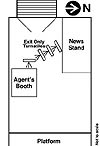
The floor plan of
the Cicero station, circa 1968. For a larger view,
click here. (Based on a sketch by Ernie
Baudler) |
The racetracks that were nearby were another factor that
added to this station's heavy usage. Sportsman's Park and
Hawthorne Park were a few miles south on Cicero and when the
horses were running, taxi cabs would line up and park in the
alley behind Cermak Road facing the south side of the
platform. Railfan Ernie Baudler remembers, "the cabbies
would shout at the top of their lungs, 'Racetrack!!
Racetrack! Going right out!'. Drivers would pack the cars as
full as they could for a flat rate per person, a dollar I
think. These cab drivers took advantage of a few
shortcomings in the "L"/bus connection at Cicero
station."
Due to the fact that the platform was sandwiched between
what was essentially a half city block, a 6-car train could
not fully berth at the platform. Thus, the CTA could never
run Douglas trains any longer than this. Baudler recalled
that "when a 6-car train would pull into the station, 1/2 of
the last car (or first depending on direction) would be
completely inaccessible to the platform actually blocking
47th court! This meant that the conductor HAD to be in the
last (or first, again, depending on direction) married pair
car set or the doors would open into the street. I did in
fact witness the doors opening in the middle of the street
on more than one occasion. Luckily, no one tried to exit.
Most riders knew they needed to walk between cars to the
doors that met the platform."
With the station house's larger size, a newsstand was
able to occupy the northwest corner of the station, operated
by a blind couple during the period of the
late-1960s/early-1970s. Baudler reminisced that "the man's
name was John. They were both totally blind and ran their
business well. In addition to newspapers and a few magazines
they sold candy and cigarettes, too. They would greet people
as soon as they heard the sound of a familiar customer's
voice and say something like, 'Hey, Ernie the Sun-Times 5
star is late today, all I have is the red streak edition.'
John and his partner (perhaps his wife?) had no trouble
telling coins apart but when you presented paper currency
for a purchase, he'd ask you what you gave him. If you said
'one' or 'five' he'd dole out the appropriate change. If
your voice was not familiar or you said '20' or '50' he'd
hold up the bill and face it toward the agent's cage and say
something like, 'Hey Charlie what've I got here?' and the
agent would then tell John what size bill he was holding. A
friendly working relationship, indeed! I always wondered
what became of John and his partner when the new station was
put into operation. No provision was made for business space
there."
New Station, New
Location
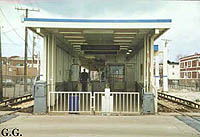
The entrance to the
Cicero station, looking west from the Cicero Avenue
crossing. The entrance bears a resemblance to Central
Park further down the line. For a larger view, click here. (Photo by Graham
Garfield) |
The original station was replaced with a larger, modern
structure, utilitarian in design, resembling Central
Park and Pulaski to the east
on the line, in 1978. Located on the west side of the street
across from the old facility, the "station house" (if it can
be called that) is essentially an open air passageway
constructed of steel, aluminum, and glass, housing the fare
controls. The platform canopy's post and beam construction,
with the supports located outside the tracks, provides for a
column-free platform. Hexagon-shaped cutouts in the
crossbeams and a split in the canopy support beams near
their base provide at least some decorative elements in this
essentially utilitarian design.
Like the old station, the new Cicero has two entrances,
the main access at Cicero and an auxiliary entrance at 49th
Avenue. The provision of the 49th Avenue entrance allowed
for the final closure of the 50th
Avenue station two blocks west. However, its longevity
was short-lived: its agent hours were reduced to weekday
morning rush only a mere four months later and the entrance
was closed entirely three years later, in 1981. 49th became
merely an auxiliary exit, as it remains today.
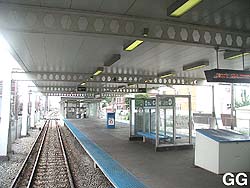
The Cicero
platform, looking west in early August 2001. For a
larger view, click here. (Photo by Graham
Garfield) |
Today, the modern structure stands with few alterations to
its original construction, except a blue and white paint
scheme, indicating its place on the Blue Line.
In December 1951, the CTA instituted A/B skip stop
service on the Douglas branch, with Cicero declared an AB
station due to its high passenger levels. In 1958, with the
Douglas Line's through-routing on the West-Northwest Route,
Cicero became a B station (like all Douglas stations,
essentially making it an all-stop), which it remained until
A/B service was discontinued on the Blue Line in 1995.
Cicero stands only a block from the massive Hawthorne
Shopping Center, named for and located adjacent to the
aforementioned old Hawthorne Works plant of the Western
Electric Company, once a major employer and maker of
telephone equipment, and architecturally notable for its
large tower and impressive Romanesque Revival design.
Douglas
Renovation Project
As part of the CTA's Douglas branch
rehabilitation project, the CTA Board
approved a $2,131,551 contract to McDonough Associates, Inc.
on August 5, 1998. McDonough Associates was to design the
improvements along the grade-level portion of the Cermak
(Douglas) route between Kildare and the terminal at 54/Cermak,
with funding for actual construction to be provided under
the Transportation Equity Act for the 21st Century, or
TEA-21.
Due to Cicero station's modern construction and it
current accessibility, very little work will be done at this
station as part of the Douglas Rehabilitation Project. The
station is already ADA compliant, can berth trains of
sufficient car length, and has modern amenities
Recent Developments
During Autumn 2004 and Spring 2005, several "L" stations
got new station name signs. As part of a multi-station
program, twelve facilities in all on the Blue, Purple, Red,
Orange, and Green lines received new, Current
Graphic Standard station name signs, replacing older KDR-type
signs that used an outdated graphic scheme that was
inconsistent with the colored line names. The new signs not
only replaced old ones in existing locations at these island
platform stations, but were added at additional locations
outside the tracks, facing to the platform, for ADA
compliance. The new additional signs outside the tracks were
mounted on new steel brackets that are supported and project
from below. Installation at all stations was complete by the
end of November 2004. Fabrication and installation of the
signs was performed by contractor Western Remac.
After conducting a West Side Corridor Study and holding
public meetings during 2004 and 2005, the
CTA began operation
of a new service over the Cermak
branch. Beginning Sunday, June 25, 2006, the new Pink Line began
providing the primary rail service to the branch. Operating
seven days a week during the same service hours as the Blue Line had
operated, Pink
Line trains operated on the Cermak
branch from 54th/Cermak to Polk, then terminated around the Loop via the Paulina
Connector and Lake
branch of the Green
Line. Service levels increased with the introduction of
the Pink Line,
with trains running more frequently including a 7.5-minute
interval during weekday rush periods. To address community
concerns, Blue
Line service to the O'Hare
branch from 54th/Cermak via
the Dearborn
Subway was maintained during morning and afternoon rush
hours. The Pink
Line and revised Blue
Line services were instituted as an 180-day experiment,
extended for additional 180-day experimental periods
subsequently, while ridership and other effects were
studied. As the experimental period continued, the
CTA revised service
on the Cermak
branch to eliminate the rush period Blue
Line trains, leaving the Pink
Line to provide all service to 54th/Cermak.
Although ridership had risen overall since the introduction
of the Pink
Line, Blue
Line trains had consistently low ridership on a
person-per-railcar-basis. The last day of Blue
Line Cermak service was Friday, April 25, 2008.

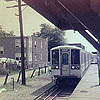
|
cta2200s01.jpg
(32k)
A 2200-series
Douglas-Milwaukee "B" train pulls into the original Cicero
station on the Douglas branch circa 1970-71. The view looks
from the north side of the platform east toward the 47th
Court entrance. (Photo by Ernie
Baudler)
|

|
cicero02.jpg
The Cicero station, looking northwest from an
adjacent alley. The platform is of the island variety with a
canopy covering both tracks and a second entrance to the
west onto 49th Avenue.
(Photo by Graham Garfield)
|
|
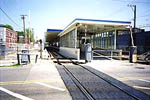
|
cicero.49th01.jpg
The 49th Avenue entrance/exit -- now an exit only --
looking east in 49th Avenue in 1999. Despite having been
designed as an auxiliary entrance, it's design is
essentially the same as the main entrance at Cicero, save
for a slightly smaller width and space for fewer turnstiles.
(Photo from the Chicago Transit Authority
Collection)
|
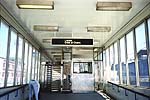
|
cicero.49th02.jpg
The fare controls at the 49th Avenue entrance,
looking east in 1999. The layout remains the same as in its
short-lived three years as an auxiliary exit: the two tall
gates on either side of the agents' booth were where the
turnstiles were. The exit-only rotogate is likely original.
One the two turnstile spaces were provided since 49th was
never meant to be a full-time, high capacity entrance.
(Photo from the Chicago Transit Authority
Collection)
|
|

|

|











